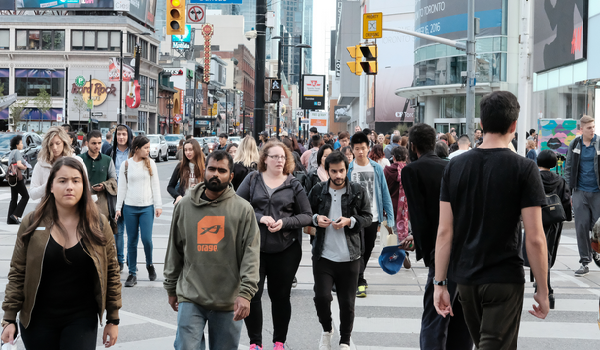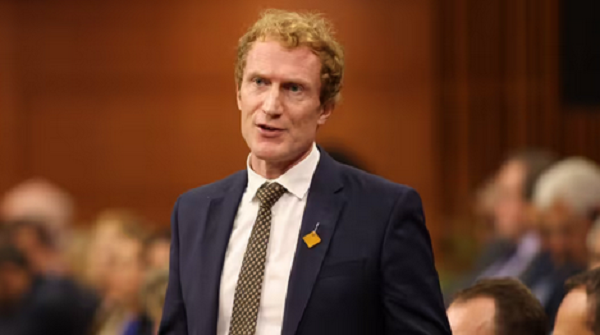Number of temporary residents in GTA surged last year – now they’re struggling to survive
Moving half a world away from her family in India, 22-year-old Radhika Raina found comfort in Brampton, where she had a cousin.
The city is a 90-minute commute to her classes in Toronto but has the cultural amenities she needed in a foreign land.
“Brampton felt like a home to me,” said Raina, who came in August for a two-year postgraduate program in addictions and mental health. The program is offered jointly by London, Ont.-based Fanshawe College and a private school.
The young woman from Mohali is among the growing ranks of temporary residents — made up of international students, foreign workers and asylum seekers — calling Canada home. It’s a part of the population that has been in the spotlight of late and scapegoated for the country’s housing crisis, health-care shortages and social tensions.
While most Canadians are nice and welcoming, Raina said, she can feel the growing tension.
“For example, a bus was full of students and a man came on and started shouting, ‘You’re in my country and you’re destroying this country,’” recalled a still-upset Raina of the incident in Brampton. “That was a first incident for me, and not just once.”
Canada’s immigration is at a crossroads, caught up in its own success as a magnet for migrants and in stuffing a pipeline of temporary residents to feed the pathways to permanent residence.
While there are few tools it can wield to turn away asylum seekers, the federal government has had a tight grip on permanent resident intake. But it has left postsecondary education institutions and employers to keep tabs on international students and temporary foreign workers, and plans have gone awry.
With only so many permanent residence spots available, an increasing number of temporary migrants have become what appears to be permanently temporary, flocking to big cities, learning to fend for themselves with little support and continuing their unfulfilled immigrant dreams.
According to Statistics Canada, temporary residents account for 6.8 per cent of the country’s population of 41 million.
The runaway growth — from just under one million in 2021 to almost 2.8 million as of April — has been under tight scrutiny, prompting the federal government to put a brake on the admission of international students and workers this year. For the first time, Ottawa is also including temporary residents in Canada’s annual immigration levels plan to be released in November.
Like permanent immigrants, temporary residents gravitate to big cities, where they have families and social connections, and expect more job opportunities. They tend to have less mobility in where they work and live because they often rely on public transit, and their study and work permits
restrict their options.
Canada has always had a difficult time spreading immigration across the country, but the sudden spike in newcomers, especially temporary residents, has exacerbated the uneven distribution, said immigration policy expert Naomi Alboim.
The federal government has introduced incentives to lure prospective permanent residents to settle in the Atlantic provinces and smaller remote communities. In the wake of an influx of asylum seekers in Montreal and Greater Toronto, Ottawa has redirected new arrivals to hotels and shelters outside of big cities.
However, both study and work permits are demand-driven, which allows post-secondary education institutions and employers to bring in as many students and workers based on their bottom line, said Alboim, who served in federal and provincial government roles in immigration and labour.
Since the recovery from the pandemic, Greater Toronto has seen significant growth in both permanent and temporary resident populations. The number of temporary residents settling in the Toronto Census Metropolitan Area reached 181,733 in 2022-23, up from 45,871 the year before, while permanent residents saw a smaller rise to 154,679 from 129,441 in the same period.
‘Canada was not prepared for the influx’
Feng Hou, Statistics Canada’s principal researcher, said the country’s temporary population has doubled over the last two years, following 150 per cent growth over a two-decade span. While much of the increase in the past came from international students, work permit holders now account for almost 55 per cent of non-permanent residents, followed by study permit holders (about 29 per cent) and asylum seekers (14 per cent) and others.
“The last two years are unique because there’s an increase in all kinds of work permits, especially in the low-skilled sectors, in restaurants and warehouses and other temporary employments,” said Hou.
“After COVID, there seemed to be a huge demand for workers in these jobs. It is the government’s response to the recovery of the economy from the pandemic. It’s driven by policy.”
Meanwhile, Canada reopened its border to international students enrolled virtually during the pandemic as well as the new cohorts. Post-secondary education institutions are concentrated in urban centres. In Greater Toronto, even colleges in smaller cities offer programs here through private colleges, catering to students’ desire to work and live in cities.
International students and temporary foreign workers have been touted as the perfect candidates for permanent residence because they are presumed to be better integrated due to their Canadian educational and employment credentials.
Slowly they feed the permanent residents pipeline through a two-step immigration process, where study and work permits become the ticket for immigration. By default, post-secondary education institutions and employers have not only become the gatekeepers to Canada, but also temporary residents’ de facto settlement service providers.
“Non-permanent residents are not eligible for most settlement services,” said Western University professor Michael Haan, whose research focuses on immigrant settlement, labour market integration and data development. “They don’t generally get much support until they become permanent residents.
“Employers aren’t necessarily concerned about whether or not an individual feels settled. They are there for employment purposes, not settlement purposes.”
As their numbers surge and the economy slows, many international students and foreign workers are floundering. A growing number have turned to food banks while others live in overcrowded and substandard rental homes.
“Canada was not prepared for the influx,” said Sulabh Mahajan, a program manager at Toronto’s Sai Dham Food Bank, which has seen the needs doubled this year, including many struggling temporary residents.
A struggle for jobs, and status
Jobs have become more difficult to come by.
Although her parents, both engineers, pay for her $16,000-a-year tuition, Raina works part time at a pizzeria to cover her expenses. She moved in January from having a private bedroom to sharing with another international student to save $200 in rent a month.
“So you land in Canada and the next morning, you have to take care of everything yourself,” said Raina, who volunteers at the food bank as well as at an opioid harm reduction program run by the Red Cross. Her temporary status and restricted work hours make it challenging to find jobs in her field. “It’s hard and stressful.”
Bikram Singh of the Naujawan Support Network, an advocacy group for migrants, said many families sold their land and borrowed money to send their kids to study in Canada. Yet international students are exploited by agents who sold them the dream, by schools that treat them as cash cows, and by bad landlords and employers who exploit them.
Increasingly, the racism and intolerance are directed at immigrants, particularly those from India, which has prompted administrators of the Toronto forum on Reddit to start removing such posts and comments, pleading with members to stop stirring up hatred.
“They have nowhere to go. They can’t go back,” said the 29-year-old activist, who came in 2019 and graduated from the automotive technician program at St. Lawrence College in 2021. His postgraduation work permit is expiring soon and he’s still without permanent residence.
“Our problems are the same as other working-class Canadians. We are not your enemies. We are not the problem.”
Although temporary residents do have pathways for permanent status, only a third end up successfully becoming permanent residents five years after receiving their first work permits, as others struggle to extend their stay in Canada.
“They may go through multiple steps and years before achieving permanent residence,” said Alboim, Canada Excellence Research Chair Program in Migration and Integration at Toronto Metropolitan University. “At every step, there’s a delay, and there’s a possibility that their application for a new or extended permit will not be successful.
“We are creating more and more opportunities for people to ‘fall out of status,’ who are really nowhere in terms of the integration process and (their) commitment to nation building.”
Living in prolonged uncertainty without knowing when one’s time is up in Canada is not only stressful, it could also delay migrants’ integration in the long run, said Western University’s Haan.
“Permanent residents are more likely to invest in their community,” said Haan. “They’re more likely to buy a home. They want to settle down. They want to fit in.”
“Non-permanent residents have a different set of considerations. They are here for a short term. They don’t necessarily have the same level of care for the community. Maybe some do, but not all of them.”
It took Mariam El Toukhy eight years to finally settle as a permanent resident in 2020 after spending four years here on a study permit for an undergraduate degree in photography and three-and-a-half years on a work permit, working at a studio.
She described the process and journey as arduous, long and unsettling. One of the frustrations was the ever-changing goalposts of the requirements.
“It’s fundamentally interrupted the trust that I felt in integrating here,” said the 29-year-old woman from Egypt, who recently graduated with a master’s degree in planning and development from TMU. “For the whole time that I’ve been living here, it never truly felt like home because my status is always in question.
“It interrupts how you navigate life. It doesn’t really feel like I am allowed to belong.”
El Toukhy said her permanent status has certainly given her a sense of stability and belonging here, but she still has a way to go for her citizenship, the next milestone.
“You’d be grateful for what you have at the end of it and know that the struggle was worth it, which it definitely was,” she said. “I’m just very happy that some of it is done and I’ll be more happy with the rest.”
This article was first reported by The Star













